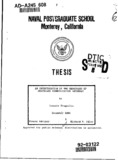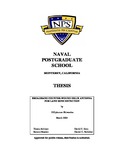A computer analysis of a conical monopole for use at naval high frequency direction finding receiving sites
| dc.contributor.advisor | Adler, Richard W. | |
| dc.contributor.author | Lemos, Panayiotis Petros | |
| dc.date | December 1992 | |
| dc.date.accessioned | 2012-11-29T16:13:48Z | |
| dc.date.available | 2012-11-29T16:13:48Z | |
| dc.date.issued | 1992-12 | |
| dc.identifier.uri | https://hdl.handle.net/10945/23580 | |
| dc.description.abstract | The Naval Security Group (NSG) High Frequency Direction Finding (HFDF) sites use large circularly disposed antenna arrays (CDAA) with moderate to high gain beams. Omnidirectional coverage is presently obtained by combing 8 to 120 elements of the CDAA. Recent measurements of site performance reveal that most HFDF sites suffer from high noise levels. Much of the noise is generated in the RF distribution system. this noise contaminates the CDAA Omni signals, greatly reducing their effectiveness. One proposed solution to the problem is to use semi-remotely located broadband conical monopole (CM) which does not connect through the noisy RF distribution system. A proof-of-performance comparing the CM and CDAA is commencing at NSG. In this thesis, the performance of the model 2012AA Conical Monopole Antenna is studied in the presence of finite ground using the Numerical Electromagnetics Code (NEC-3). Ground constants used in this study were obtained for two locations where the CM are installed: Northwest, VA and Winter Harbor, ME. The performance of the combined antenna/ground system was simulated over a frequency range of 2 to 30 MHz (FM), for various ground constants, with particular emphasis on the elevation plane radiation patterns. The study concludes that the CM operates effectively in the frequency range of interest with some exceptions. These occur at frequencies where there is a probable transitional range where the mode of operation if the antenna is transferred from that of an inverted cone to that of a broad monopole. Finally, this study confirms that in order for an antenna/ground model to provide a representative and effective simulation, the ground constants in the vicinity of the antenna should be carefully measured and averaged over an adequate number of samples. | en_US |
| dc.description.uri | http://archive.org/details/acomputernalysis1094523580 | |
| dc.format.extent | 2 v. | en_US |
| dc.language.iso | en_US | |
| dc.publisher | Monterey, California. Naval Postgraduate School | en_US |
| dc.rights | Copyright is reserved by the copyright owner | en_US |
| dc.title | A computer analysis of a conical monopole for use at naval high frequency direction finding receiving sites | en_US |
| dc.type | Thesis | en_US |
| dc.contributor.secondreader | Vincent, Wilbur R. | |
| dc.contributor.corporate | Naval Postgraduate School | |
| dc.contributor.department | Department of Electrical and Computer Engineering | |
| dc.subject.author | Antenna | en_US |
| dc.subject.author | HF | en_US |
| dc.subject.author | Conical monopole | en_US |
| dc.subject.author | Direction finding | en_US |
| dc.description.service | Lieutenant, Hellenic Navy | en_US |
| etd.thesisdegree.name | M.S. in Electrical Engineering | en_US |
| etd.thesisdegree.level | Masters | en_US |
| etd.thesisdegree.discipline | Electrical Engineering | en_US |
| etd.thesisdegree.grantor | Naval Postgraduate School | en_US |
| dc.description.distributionstatement | Approved for public release; distribution is unlimited. |
Files in this item
This item appears in the following Collection(s)
-
1. Thesis and Dissertation Collection, all items
Publicly releasable NPS Theses, Dissertations, MBA Professional Reports, Joint Applied Projects, Systems Engineering Project Reports and other NPS degree-earning written works.





